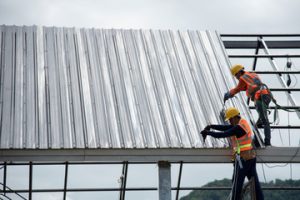Commercial Roofing involves many of the same concepts as Residential Roofing, but with more complicated requirements and standards. These unique specifications must be taken into account to ensure the roof’s construction and function.

Commercial property owners must ensure their roofs are in good condition to avoid costly damages that lead to leaks and unappealing curb front appearances. This requires regular inspections, timely repairs and a robust maintenance schedule. Find Out More Here to learn more.
The most popular roofing material in North America, asphalt shingles offer the perfect blend of cost-effectiveness and aesthetics. Known as composition shingles, they are a composite product that is made from fiberglass or cellulose mat and coated with asphalt. These shingles are available in four different styles and colors, which work well with a wide range of home architectural designs. The combination of their affordability, easy installation, and weather resistance make them a great choice for homeowners.
While the popularity of asphalt shingles is no surprise, it may be surprising to learn that they are actually much older than you think. They evolved from a mid-19th century style of roof coating that used layers of felt saturated with coal tar. Those early shingles were a staple in residential roofing, but they did not hold up well to the rigors of commercial roofing applications.
Today, shingle manufacturers use a process that allows them to add extra strength and durability to their products. The basic components of a modern shingle are a durable, lightweight fiberglass mat that is embedded with a layer of hot asphalt and topped with a ceramic-coated mineral granule surface. The granules help protect the asphalt from damage and UV radiation. They also add color and enhance the appearance of the shingle, while protecting the fiberglass or cellulose core underneath.
The waterproof asphalt coating on top is what makes the shingles resistant to all types of weather conditions. They can withstand scorching heat, heavy rains, and snowfall. They are designed to shed water, preventing it from pooling and damaging the attic. In addition, their thickness and construction prevents air infiltration and moisture penetration, keeping the interior of the structure a comfortable temperature throughout the year.
For those seeking to upgrade the aesthetics of their roof, luxury shingles are an excellent option. They resemble other high-end roofing materials, such as slate and cedar shakes, and are available in multiple styles. They are thicker and heavier than 3-tab shingles, offering superior durability and longer warranties. Some of them even have a class 4 impact-resistant rating, which can reduce the homeowner’s insurance premium.
Metal
When it comes to commercial roofing, metal is an excellent option for a number of reasons. First, it’s very durable and long-lasting. In addition, it holds up to harsh weather conditions like high winds and heavy rains. Moreover, it can protect the interior of a building from leaks. Lastly, it can last for up to 70 years without needing replacement.
Another benefit of metal is that it’s fire-resistant. This is important because it prevents the spreading of a fire throughout the entire building and saves the lives of people inside. In contrast, a shingle roof can spread a fire to the interior of a building with ease and cause extensive damage.
In addition to being fire-resistant, metal is also very energy efficient. This is because it reflects the sun’s rays and can reduce the amount of heat that enters a building. As a result, it can save businesses money on their utility bills.
There are a variety of different types of metal roofing available. Some are designed to look like traditional shingles while others are more modern in appearance. For example, the DECRA metal shingle is an excellent choice for those looking to combine durability and aesthetics. It’s available in a range of colors and reflective properties, which means that you can choose the perfect style for your business.
Moreover, there are other types of metal roofing that offer more durability than asphalt shingles. For instance, steel roofing panels are an excellent option for those looking for a long-lasting solution that’s resistant to harsh weather conditions. Metal roofing is also more resistant to hail than shingle roofs. In fact, some metal roofs are even rated for impact resistance, which makes them a good choice for areas with frequent hail storms.
One disadvantage of a metal roof is that it can be more expensive than an asphalt shingle roof. However, the initial investment will pay off over time. A metal roof can also increase the value of a property, making it easier to sell when the time comes.
One of the most popular types of metal roofing is galvalume. This is an aluminum and zinc alloy that’s highly durable and can withstand extreme temperatures. It’s also able to resist the effects of salty air, which is an important factor if you live near water. Additionally, galvalume is available in a variety of panel profiles, which allows it to fit well with a number of different architectural styles.
EPDM Rubber
EPDM is a type of synthetic rubber that is commonly used in commercial roofing because of its energy efficiency, durability, and versatility. Its energy-efficient nature helps reduce your commercial property’s heating and cooling costs, while its durability and weather resistance make it a cost-effective option for long-term protection. The material also has low environmental impact and is compatible with many green building initiatives.
EPDM roofs are typically installed on flat or low-slope buildings. They are usually constructed of one large sheet, which reduces the number of seams and provides added strength to your roof. This membrane is highly durable and can withstand the elements for decades. It also resists UV radiation, ozone, and extreme temperatures, making it a strong choice for a commercial roofing solution.
Unlike other roofing materials, EPDM has minimal maintenance needs. A few inspections every 2 to 3 years are typically sufficient to catch small issues and repair them before they grow into major problems.
When a problem does occur, it is easy to repair EPDM with patch kits and adhesive sealants. These simple tools can make the repairs fast and convenient, keeping your business’s roofing system up to date and protecting your employees and inventory.
If you are interested in using EPDM for your commercial roof, be sure to hire an experienced roofing contractor. They can help you choose the right membrane to suit your roof, and they will inspect and prepare your existing structure to ensure a solid installation and long-lasting performance.
The process for installing EPDM on a flat or low-slope roof is relatively simple. The professional roofing team will inspect the roof to determine if it can support the new material, and they will clear away any debris or old roofing materials to prepare the surface for installation. They will also check for any damage or structural issues that may require additional attention to prevent further problems.
Once the roof has been properly inspected and prepared, the installers will begin laying the membrane. They will trim it to fit the shape of your roof, paying special attention to the seams to ensure they remain watertight and durable. Then, they will seal the seams with bonding adhesive or tape to prevent leaks.
Single-Ply Membranes
Single-ply membranes consist of a single layer of material applied over a commercial roof’s existing roof deck and insulation, mechanically attached or adhered, with heat-welded seams. They are available in a variety of thicknesses, color options and performance characteristics to meet the unique requirements for different roofing conditions and environmental factors.
Thermoplastic polyolefin (TPO) and Polyvinyl Chloride (PVC) are two of the most popular single-ply membranes. These systems offer a range of cost-effective, energy efficient and durable protection for commercial buildings, including light-colored membranes that reflect sunlight to lower cooling costs. Other benefits include superior resistance to weathering and chemical exposure, as well as flexibility to accommodate a building’s expansion and contraction over time.
Both TPO and PVC offer outstanding puncture and impact resistance, as well as durability against harsh chemicals, fire, and ultraviolet radiation. They are also lightweight, which contributes to ease of installation and lower labor costs compared to traditional construction materials. Thermoplastic membranes also resist ozone, UV rays, and other weather conditions that negatively impact traditional bitumen-based roof coatings.
In addition to their durability and longevity, single-ply membranes are easy to maintain, with little or no downtime for repairs or replacement. These systems also have a low moisture content and require less frequent cleaning, which is ideal for facilities that house sensitive equipment or chemicals.
The membranes are factory-manufactured sheet membranes that are either thermoplastic or thermoset, and they may or may not contain reinforcement layers. Thermoplastic membranes soften when heated and harden when cooled, while thermoset membranes solidify, or set, irreversibly after heating. Some common reinforcements include polyester fabrics or scrim, glass fiber, and felt or fleece.
Most single-ply membranes can be installed in one of three ways: fully adhered, mechanically attached, or ballasted. Choosing the appropriate method for your facility and budget will ensure the best installation results.

